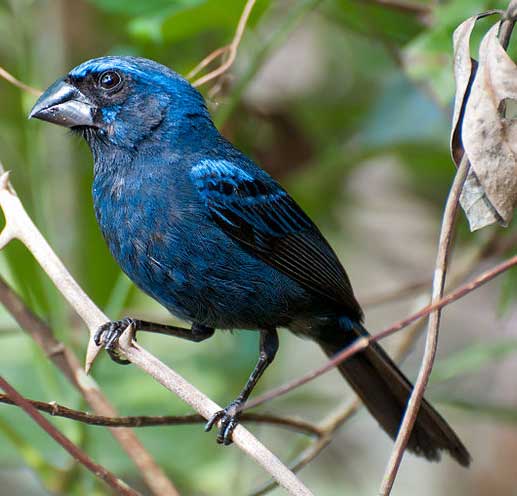
Cyanoloxia brissonii (*)
Superregnum: Eukaryota
Regnum: Animalia
Subregnum: Eumetazoa
Cladus: Bilateria
Cladus: Nephrozoa
Superphylum: Deuterostomia
Phylum: Chordata
Subphylum: Vertebrata
Infraphylum: Gnathostomata
Megaclassis: Osteichthyes
Cladus: Sarcopterygii
Cladus: Rhipidistia
Cladus: Tetrapodomorpha
Cladus: Eotetrapodiformes
Cladus: Elpistostegalia
Superclassis: Tetrapoda
Cladus: Reptiliomorpha
Cladus: Amniota
Classis: Reptilia
Cladus: Eureptilia
Cladus: Romeriida
Subclassis: Diapsida
Cladus: Sauria
Infraclassis: Archosauromorpha
Cladus: Crurotarsi
Divisio: Archosauria
Cladus: Avemetatarsalia
Cladus: Ornithodira
Subtaxon: Dinosauromorpha
Cladus: Dinosauriformes
Cladus: Dracohors
Cladus: Dinosauria
Ordo: Saurischia
Cladus: Eusaurischia
Cladus: Theropoda
Cladus: Neotheropoda
Cladus: Averostra
Cladus: Tetanurae
Cladus: Avetheropoda
Cladus: Coelurosauria
Cladus: Tyrannoraptora
Cladus: Maniraptoromorpha
Cladus: Maniraptoriformes
Cladus: Maniraptora
Cladus: Pennaraptora
Cladus: Paraves
Cladus: Eumaniraptora
Cladus: Avialae
Infraclassis: Aves
Cladus: Euavialae
Cladus: Avebrevicauda
Cladus: Pygostylia
Cladus: Ornithothoraces
Cladus: Euornithes
Cladus: Ornithuromorpha
Cladus: Ornithurae
Cladus: Carinatae
Parvclassis: Neornithes
Cohors: Neognathae
Cladus: Neoaves
Cladus: Telluraves
Cladus: Australaves
Ordo: Passeriformes
Subordo: Passeri
Infraordo: Passerida
Superfamilia: Passeroidea
Familia: Cardinalidae
Genus: Cyanoloxia
Species: Cyanoloxia brissonii
Subspecies: C. b. argentina – C. b. brissonii – C. b. caucae – C. b. minor – C. b. sterea
Name
Cyanoloxia brissonii (Lichtenstein, 1823)
Synonyms
Fringilla brissonii (protonym)
Loxia cyanea Linnaeus, 1758 = Cyanocompsa cyanea Syst.Nat p. 174
Passerina brissonii (Lichtenstein, 1823)
Cyanocompsa brissonii (Lichtenstein, 1823)
References
Primary references
Lichtenstein, M.H.C. 1823. Verzeichniss der Doubletten des zoologischen Museums der Königl. Universität zu Berlin nebst Beschreibung vieler bisher unbekannter Arten von Säugethieren, Vögeln, Amphibien und Fischen. 118 pp. Königl. Preuss. Akad. Wiss./ T. Trautwein, Berlin. Original description p. 22 no. 218 BHL DOI: 10.5962/bhl.title.40281 Reference page.
Additional references
Bryson, R.W.; Chaves, J.; Smith, B.T.; Miller, M.J.; Winker, K.; Pérez-Emán, J.L. & Klicka, J. 2014. Diversification across the New World within the ‘blue’ cardinalids (Aves: Cardinalidae). Journal of Biogeography 41(3): 587-599. DOI: 10.1111/jbi.12218Reference page.
Vernacular names
English: Ultramarine Grosbeak
español: Picogrueso de Brisson
português do Brasil: Azulão
português: Azulão-verdadeiro
The ultramarine grosbeak (Cyanoloxia brissonii) is a species of grosbeak in the family Cardinalidae. It is found in a wide range of semi-open habitats in eastern and central South America, with a disjunct population in northern South America.
Description
These birds are 15 cm long. The adult male exhibits a dark-blue plumage with bright-blue upper-wings. The females and the juveniles are brown.
The ultramarine grosbeak is territorial; it doesn't fly in flocks. If a male invades the territory of another, for sure there will be a conflict with some violence.
Distribution and habitat
They inhabit the edge of swamps, secondary forests and plantations. The native range of these birds extends from Northeast and central Brazil, Bolivia, Paraguay to Argentina. The also can be found northern Venezuela and Colombia. There are some morphological differences between subspecies from different regions.
Behaviour and ecology
Breeding
It takes place between September and February, builds its nest not far from the ground and each clutch usually has between 2 and 3 eggs. The chicks are born between 13 and 15 days after the eggs are laid.
Feeding
Feeds on seeds, fruits and insects.
References
BirdLife International (2016). "Cyanoloxia brissonii". IUCN Red List of Threatened Species. 2016: e.T22723932A94841030. doi:10.2305/IUCN.UK.2016-3.RLTS.T22723932A94841030.en. Retrieved 12 November 2021.
BirdLife International 2012. "Cyanocompsa brissonii". IUCN Red List of Threatened Species. Version 2012.1. International Union for Conservation of Nature.
Hilty, S. 2003. Birds of Venezuela. Christopher Helm. Londres.
Further reading
Bryson, R.W. Jr; Chaves, J.; Smith, B.T.; Miller, M.J.; Winker, K.; Pérez-Emán, J.L.; Klicka, K. (2014). "Diversification across the New World within the 'blue' cardinalids (Aves: Cardinalidae)". Journal of Biogeography. 41 (3): 587–599. doi:10.1111/jbi.12218.
Retrieved from "http://en.wikipedia.org/"
All text is available under the terms of the GNU Free Documentation License

